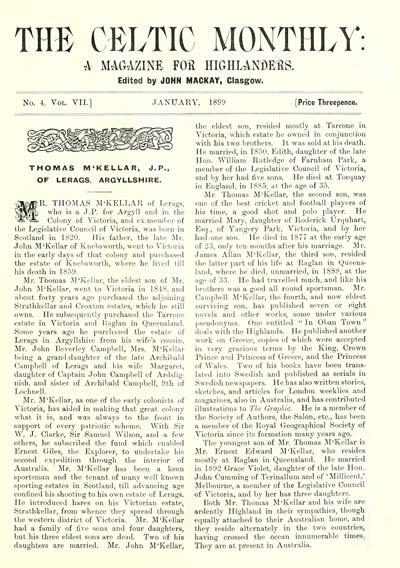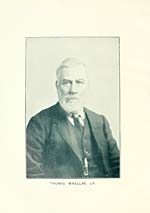Blair Collection > Celtic monthly > Volume 7, 1899
(95)
Download files
Complete book:
Individual page:
Thumbnail gallery: Grid view | List view

THE CELTIC MONTHLY:
A MAGAZINE FOS HIGHLANDERS.
Edited by JOHN MACKAY, Glasgow.
No. 4. Vol. VII.]
JANUARY, 1899
[Price Tlireepence.
THOMAS M'KEULAR, J. P.,
OF LERAGS. ARGYLLSHIRE.
^«RR. THOMAS M'KELLAR of Lerags,
Vm^lp wlio is a J. P. for Argyll and in the
— '— Colony of Victoria, and ex-member of
the Legislative Council of Victoria, was born in
Scotland in 1820. His father, the late Mr.
John M'Kellar of Knebsvvorth, went to Victoria
in the early days of that colony and purchased
the estate of Knebsworth, where he lived till
his death in 1859.
Mr. Thomas M'Kellar, the eldest son of Mr.
John M'Kellar, went to Victoria in 1848, and
about forty years ago purchased the adjoining
Strathkellar and Croxton estates, which he still
owns. He subsequently purchased the Tarrone
estate in Victoria and Kaglan in Queensland.
Some years ago he purchased the estate of
Lerags in Argyllshire from his wife's cousin,
Mr. John Beverley Campbell, Mrs. M'Kellar
being a grand-daughter of the late Archibald
Campbell of Lerags and his wife Margaret,
daughter of Captain John Campbell of Ardslig-
nish, and sister of Archibald Campbell, 9th of
Lochnell.
Mr. M'Kellar, as one of the early colonists of
Victoria, has aided in making that great colony
what it is, and was always to the front in
support of every patriotic scheme. With Sir
W. J. Clarke, Sir Samuel Wilson, and a few
others, he subscribed the fund which enabled
Ernest Giles, the Explorer, to undertake his
second expedition through the interior of
Australia. Mr. M'Kellar has been a keen
sportsman and the tenant of many well known
sporting estates in Scotland, till advancing age
confined his shooting to his own estate of Lerags.
He introduced hares on his Victorian estate,
Strathkellar, from whence they spread through
the western district of Victoria. Mr. M'Kellar
had a family of five sons and four daughters,
but his three eldest sons are dead. Two of his
daughters are married. Mr. John M'Kellar,
the eldest son, resided mostly at Tarrone in
Victoria, which estate he owned in conjunction
with his two brothers. It was sold at his death.
He married, in IS-'iO, Edith, daughter of the late
Hon. William Rutledge of Farnham Park, a
member of the Legislative Council of Victoria,
and by her had five sons. He died at Torquay
in England, in 1885, at the age of 35.
Mr. Thomas M'Kellar, the second son, was
one of the best cricket and football players of
his time, a good shot and polo player. He
married Mary, daughter of Roderick IJrquhart,
Esq., of Yangery Park, Victoria, and by her
had one son. He died in 1877 at the early age
of 23, only ten months after his marriage. Mr.
James Allan M'Kellar, the third son, resided
the latter part of his life at Raglan in Queens-
land, where he died, unmarried, in 1888, at the
age of 33. He had travelled much, and like his
brothers was a good all round sportsman. Mr.
Campbell M'Kellar, the fourth, and now eldest
surviving son, has published seven or eight
novels and other works, some under various
])seudonyms. One entitled " In Oban Town "
deals with the Highlands. He published another
work on Greece, copies of which were accepted
in very gracious terms by the King, Crown
Prince and Princess of Greece, and the Princess
of Wales. Two of his books have been trans-
lated into Swedish and published as serials in
Swedish newspapers. He has also written stories,
sketches, and articles for London weeklies and
magazines, also in Australia, and has contributed
illustrations to The Graphic. He is a member of
the Society of Authors, the Salon, etc., has been
a member of the Royal Geographical Society of
Victoria since its formation many years ago.
The youngest son of Mr. Thomas M'Kellar is
Mr. Ernest; Edward M'Kellar, who resides
mostly at Raglan in Queensland. He married
in 1892 Grace Violet, daughter of the late Hon.
John Gumming of Terinallum and of 'Millicent,'
Melbourne, a member of the Legislative Council
of Victoria, and by her has three daughters.
Both Mr. Thomas M'Kellar and his wife are
ardently Highland in theii sympathies, though
equally attached to their Australian home, and
they reside alternately in the two countries,
having crossed the ocean innumerable times.
They are at present in Australia.
A MAGAZINE FOS HIGHLANDERS.
Edited by JOHN MACKAY, Glasgow.
No. 4. Vol. VII.]
JANUARY, 1899
[Price Tlireepence.
THOMAS M'KEULAR, J. P.,
OF LERAGS. ARGYLLSHIRE.
^«RR. THOMAS M'KELLAR of Lerags,
Vm^lp wlio is a J. P. for Argyll and in the
— '— Colony of Victoria, and ex-member of
the Legislative Council of Victoria, was born in
Scotland in 1820. His father, the late Mr.
John M'Kellar of Knebsvvorth, went to Victoria
in the early days of that colony and purchased
the estate of Knebsworth, where he lived till
his death in 1859.
Mr. Thomas M'Kellar, the eldest son of Mr.
John M'Kellar, went to Victoria in 1848, and
about forty years ago purchased the adjoining
Strathkellar and Croxton estates, which he still
owns. He subsequently purchased the Tarrone
estate in Victoria and Kaglan in Queensland.
Some years ago he purchased the estate of
Lerags in Argyllshire from his wife's cousin,
Mr. John Beverley Campbell, Mrs. M'Kellar
being a grand-daughter of the late Archibald
Campbell of Lerags and his wife Margaret,
daughter of Captain John Campbell of Ardslig-
nish, and sister of Archibald Campbell, 9th of
Lochnell.
Mr. M'Kellar, as one of the early colonists of
Victoria, has aided in making that great colony
what it is, and was always to the front in
support of every patriotic scheme. With Sir
W. J. Clarke, Sir Samuel Wilson, and a few
others, he subscribed the fund which enabled
Ernest Giles, the Explorer, to undertake his
second expedition through the interior of
Australia. Mr. M'Kellar has been a keen
sportsman and the tenant of many well known
sporting estates in Scotland, till advancing age
confined his shooting to his own estate of Lerags.
He introduced hares on his Victorian estate,
Strathkellar, from whence they spread through
the western district of Victoria. Mr. M'Kellar
had a family of five sons and four daughters,
but his three eldest sons are dead. Two of his
daughters are married. Mr. John M'Kellar,
the eldest son, resided mostly at Tarrone in
Victoria, which estate he owned in conjunction
with his two brothers. It was sold at his death.
He married, in IS-'iO, Edith, daughter of the late
Hon. William Rutledge of Farnham Park, a
member of the Legislative Council of Victoria,
and by her had five sons. He died at Torquay
in England, in 1885, at the age of 35.
Mr. Thomas M'Kellar, the second son, was
one of the best cricket and football players of
his time, a good shot and polo player. He
married Mary, daughter of Roderick IJrquhart,
Esq., of Yangery Park, Victoria, and by her
had one son. He died in 1877 at the early age
of 23, only ten months after his marriage. Mr.
James Allan M'Kellar, the third son, resided
the latter part of his life at Raglan in Queens-
land, where he died, unmarried, in 1888, at the
age of 33. He had travelled much, and like his
brothers was a good all round sportsman. Mr.
Campbell M'Kellar, the fourth, and now eldest
surviving son, has published seven or eight
novels and other works, some under various
])seudonyms. One entitled " In Oban Town "
deals with the Highlands. He published another
work on Greece, copies of which were accepted
in very gracious terms by the King, Crown
Prince and Princess of Greece, and the Princess
of Wales. Two of his books have been trans-
lated into Swedish and published as serials in
Swedish newspapers. He has also written stories,
sketches, and articles for London weeklies and
magazines, also in Australia, and has contributed
illustrations to The Graphic. He is a member of
the Society of Authors, the Salon, etc., has been
a member of the Royal Geographical Society of
Victoria since its formation many years ago.
The youngest son of Mr. Thomas M'Kellar is
Mr. Ernest; Edward M'Kellar, who resides
mostly at Raglan in Queensland. He married
in 1892 Grace Violet, daughter of the late Hon.
John Gumming of Terinallum and of 'Millicent,'
Melbourne, a member of the Legislative Council
of Victoria, and by her has three daughters.
Both Mr. Thomas M'Kellar and his wife are
ardently Highland in theii sympathies, though
equally attached to their Australian home, and
they reside alternately in the two countries,
having crossed the ocean innumerable times.
They are at present in Australia.
Set display mode to: Large image | Transcription
Images and transcriptions on this page, including medium image downloads, may be used under the Creative Commons Attribution 4.0 International Licence unless otherwise stated. ![]()
| Early Gaelic Book Collections > Blair Collection > Celtic monthly > Volume 7, 1899 > (95) |
|---|
| Permanent URL | https://digital.nls.uk/75859639 |
|---|
| Shelfmark | Blair.59 |
|---|---|
| Additional NLS resources: | |
| Attribution and copyright: |
|
| Description | A selection of books from a collection of more than 500 titles, mostly on religious and literary topics. Also includes some material dealing with other Celtic languages and societies. Collection created towards the end of the 19th century by Lady Evelyn Stewart Murray. |
|---|
| Description | Selected items from five 'Special and Named Printed Collections'. Includes books in Gaelic and other Celtic languages, works about the Gaels, their languages, literature, culture and history. |
|---|

